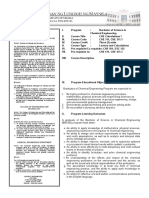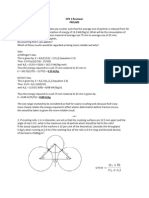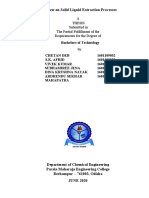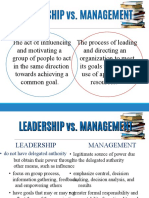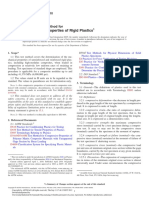Friction in Pipes
Friction in Pipes
Uploaded by
阿尔坎塔拉约翰·肯尼斯Copyright:
Available Formats
Friction in Pipes
Friction in Pipes
Uploaded by
阿尔坎塔拉约翰·肯尼斯Copyright
Available Formats
Share this document
Did you find this document useful?
Is this content inappropriate?
Copyright:
Available Formats
Friction in Pipes
Friction in Pipes
Uploaded by
阿尔坎塔拉约翰·肯尼斯Copyright:
Available Formats
Republic of the Philippines
BATANGAS STATE UNIVERSITY
The National Engineering University
Alangilan Campus
Golden Country Homes, Alangilan Batangas City, Batangas, Philippines 4200
Tel Nos.: (+63 143) 425-0139 local 2121 / 2221
E-mail Address: ceafa@g.batstate-u.edu.ph | Website Address: http://www.batstate-u.edu.ph
College of Engineering – Department of Chemical Engineering
FRICTION IN PIPES LABORATORY SIMULATION
Laboratory Examination
by:
Abejuro, Joshua R.
Alcantara, John Kenneth E.
Alvarez, Pamela L.
Latunio, Katherine E.
Mabini, Jessica L.
Panganiban, Jasmine Mae M.
ChE-2102
Sir Jiro Vince Allen Marinay
Professor
Leading Innovations, Transforming Lives, Building the Nation
Republic of the Philippines
BATANGAS STATE UNIVERSITY
The National Engineering University
Alangilan Campus
Golden Country Homes, Alangilan Batangas City, Batangas, Philippines 4200
Tel Nos.: (+63 243) 425-0139 local 2121 / 2221
E-mail Address: ceafa@g.batstate-u.edu.ph | Website Address: http://www.batstate-u.edu.ph
College of Engineering – Department of Chemical Engineering
I. INTRODUCTION
A friction force is generally formed along the pipe wall against the fluid as an
incompressible fluid moves through a pipe. As the fluid passes through the pipe, the frictional
resistance causes a continual loss of energy, or total head, in the fluid, which lowers the fluid's
pressure. Numerous factors can stop a fluid from flowing through a pipe, which results in friction
loss in the pipes. The velocity of the fluid, the pipe's internal diameter, its length, and the pipe's
interior surface roughness are the four variables that affect friction losses in the pipe. Plumbing
fixtures like elbows, valves, and junctions, as well as friction caused by the rapid contraction or
expansion of the pipe's internal surface, all contribute to small head losses.
The relationship between the diameters of the pipes, head loss, friction factor, flow rate,
and water velocity in each pipe will be the main emphasis of this experiment. To calculate the
head loss, flow rate, and velocity, the Friction in the Pipes experiment simulator will be used.
Additionally, the Darcy Equation can be used to get the analytical friction factor for each pipe.
Based on the fluid's velocity and the frictional resistance, this theoretical equation forecasts the
loss of frictional energy in a pipe. It is almost primarily used to figure out the frictional head loss
in turbulent flows.
𝑓𝑙𝑣
𝐻=
𝑑𝑔
Where:
H = Head Loss
f = Analytical Friction Factor
l = Length of the pipe
d = Pipe diameter
v = Mean velocity
g = acceleration due to gravity
Leading Innovations, Transforming Lives, Building the Nation
Republic of the Philippines
BATANGAS STATE UNIVERSITY
The National Engineering University
Alangilan Campus
Golden Country Homes, Alangilan Batangas City, Batangas, Philippines 4200
Tel Nos.: (+63 343) 425-0139 local 2121 / 2221
E-mail Address: ceafa@g.batstate-u.edu.ph | Website Address: http://www.batstate-u.edu.ph
College of Engineering – Department of Chemical Engineering
II. OBJECTIVES
To determine head loss due to friction in the specified pipe diameter and hence
determine the friction factor.
To compare and determine the relationship of the computed flow rate and velocity
to its respective pipe diameter
To compare and determine the relationship of the computed flow rate and velocity
of each of the pipe diameters to the computed analytical friction factor
III. APPARATUS USED
Pipes having different diameters are connected to a differential manometer
Collecting tank
Stopwatch
Scale
IV. PROCEDURES
These procedure steps will be followed on the simulator.
1. Open Friction in Pipes experiment, a window will appear as shown.
2. Select the required diameter of the pipe, then click the NEXT button.
Leading Innovations, Transforming Lives, Building the Nation
Republic of the Philippines
BATANGAS STATE UNIVERSITY
The National Engineering University
Alangilan Campus
Golden Country Homes, Alangilan Batangas City, Batangas, Philippines 4200
Tel Nos.: (+63 443) 425-0139 local 2121 / 2221
E-mail Address: ceafa@g.batstate-u.edu.ph | Website Address: http://www.batstate-u.edu.ph
College of Engineering – Department of Chemical Engineering
3. Click on the selected pipe inlet valve to allow the flow through it.
4. Click on the main inlet valve to allow the flow through it and then click on the pipe valve
to allow water flow to test for air bubbles.
5. Click on the knot to change from the isolated position to the air-vent position and again
click to change it to the read position.
Leading Innovations, Transforming Lives, Building the Nation
Republic of the Philippines
BATANGAS STATE UNIVERSITY
The National Engineering University
Alangilan Campus
Golden Country Homes, Alangilan Batangas City, Batangas, Philippines 4200
Tel Nos.: (+63 543) 425-0139 local 2121 / 2221
E-mail Address: ceafa@g.batstate-u.edu.ph | Website Address: http://www.batstate-u.edu.ph
College of Engineering – Department of Chemical Engineering
6. Now click on the tank outlet valve to open and allow flow, note the manometer reading.
7. Here click on the tank outlet valve to close and then calculate the Head Loss value.
8. Calculate the discharge, velocity, and analytical friction factor with the help of the
observation given here.
Leading Innovations, Transforming Lives, Building the Nation
Republic of the Philippines
BATANGAS STATE UNIVERSITY
The National Engineering University
Alangilan Campus
Golden Country Homes, Alangilan Batangas City, Batangas, Philippines 4200
Tel Nos.: (+63 643) 425-0139 local 2121 / 2221
E-mail Address: ceafa@g.batstate-u.edu.ph | Website Address: http://www.batstate-u.edu.ph
College of Engineering – Department of Chemical Engineering
9. Repeat the same procedure for other trials.
V. RESULTS AND DISCUSSION
TABLE 1: TRIAL 1-3 FOR 50 MM DIAMETER PIPE
50 mm Trial Head Final Initial Rise Time Flowrate Velocity Analytical
Diameter Loss Reading Reading (h) required (Qact) (cm/s) Friction
Pipe (cm) (cm) (cm) (cm) to fill (cm3/s) Factor
(sec)
1 75.6 65 55 10 31 1129.0322 57.5303 0.7469
2 126 65 55 10 18 1944.4444 97.0799 0.4197
3 88.2 65 55 10 27 1296.2962 66.0533 0.6610
AVERAGE 0.6092
Table 1 shows the results of the simulation after the three trials of the experiment for the
50 mm diameter pipe. The computed head losses for the three trials are 75.6cm, 126cm, and
88.2cm respectively. Furthermore, 1129.0322cm3/s, 1944.4444cm3/s, and 1296.2962cm3/s were
the values of the flow rate after the three trials of simulations. With regards to the velocity, the
computed values were 57.5303cm/s, 97.0799cm/s, and 66.0533cm/s respectively. Lastly, the
analytical friction factor of the three trials includes 0.7469, 0.4197, and 0.6610 with an average
friction factor of 0.6092.
Leading Innovations, Transforming Lives, Building the Nation
Republic of the Philippines
BATANGAS STATE UNIVERSITY
The National Engineering University
Alangilan Campus
Golden Country Homes, Alangilan Batangas City, Batangas, Philippines 4200
Tel Nos.: (+63 743) 425-0139 local 2121 / 2221
E-mail Address: ceafa@g.batstate-u.edu.ph | Website Address: http://www.batstate-u.edu.ph
College of Engineering – Department of Chemical Engineering
TABLE 2: TRIAL 1-3 FOR 40 MM DIAMETER PIPE
40 mm Trial Head Final Initial Rise Time Flowrate Velocity Analytical
Diameter Loss Reading Reading (h) required (Qact) (cm/s) Friction
Pipe (cm) (cm) (cm) (cm) to fill (cm3/s) Factor
(sec)
1 144.9 65 55 10 19 1842.1052 146.6644 0.1762
2 132.3 65 55 10 23 1521.7391 121.1575 0.2358
3 107.1 65 55 10 30 1166.6666 92.8874 0.3247
AVERAGE 0.2456
Table 2 displays the simulation's findings following the experiment's three attempts with
a pipe with a diameter of 40 mm. The three trials' computed head losses are 144.9cm, 132.3cm,
and 107.1cm, respectively. Moreover, the flowrate results following the three simulation runs
were 1842.1052cm3/s, 1521.7391cm3/s, and 1166.6666cm3/s while the calculated speeds for
velocity were 146.6644cm/s, 121.1575cm/s, and 92.8874cm/s, respectively. Lastly, the three
trials' analytical friction factors are 0.1762, 0.2358, and 0.3247, with a mean of 0.2456.
TABLE 3: TRIAL 1-3 FOR 25 MM DIAMETER PIPE
25 mm Trial Head Final Initial Rise Time Flowrate Velocity Analytical
Diameter Loss Reading Reading (h) required (Qact) (cm/s) Friction
3
Pipe (cm) (cm) (cm) (cm) to fill (cm /s) Factor
(sec)
1 73.71 65 55 10 35 1000 203.75 0.0290
2 97.65 65 55 10 30.2 1158.9403 236.13 0.0286
3 73.71 65 55 10 35 1000 203.75 0.0290
AVERAGE 0.0289
Leading Innovations, Transforming Lives, Building the Nation
Republic of the Philippines
BATANGAS STATE UNIVERSITY
The National Engineering University
Alangilan Campus
Golden Country Homes, Alangilan Batangas City, Batangas, Philippines 4200
Tel Nos.: (+63 843) 425-0139 local 2121 / 2221
E-mail Address: ceafa@g.batstate-u.edu.ph | Website Address: http://www.batstate-u.edu.ph
College of Engineering – Department of Chemical Engineering
The findings of the simulation following the three experiments for the 25 mm diameter
pipe are shown in table 3. The calculated head losses for the three trials are, respectively, 73.71
cm, 97.65 cm, and 73.71 cm. Additionally, following three simulation runs, the flow rate was
recorded as 1000cm3/s, 1158.9403cm3/s, and 1000cm3/s. The velocity was computed to be
203.75 cm/s, 236.13 cm/s, and 203.75 cm/s, respectively. Lastly, the analytical friction factor for
the three tests is 0.0290, 0.0286, and 0.0290, with an average friction factor of 0.0289.
TABLE 4: TRIAL 1-3 FOR 20 MM DIAMETER PIPE
20 mm Trial Head Final Initial Rise Time Flowrate Velocity Analytical
Diameter Loss Reading Reading (h) required (Qact) (cm/s) Friction
3
Pipe (cm) (cm) (cm) (cm) to fill (cm /s) Factor
(sec)
1 145.475 65 55 10 43.5 804.5977 256.2413 0.0290
2 107.1 65 55 10 47.5 736.8421 234.663 0.0254
3 81.9 65 55 10 55.50 630.6306 200.8377 0.0266
AVERAGE 0.0270
The results of the simulation after three rounds of the experiment using a pipe with a
diameter of 20 mm are shown in Table 4. Calculated head losses for the three trials are
145.475cm, 107.1cm, and 81.9cm, respectively. Additionally, the three simulation runs produced
flowrate findings of 804.5977cm3/s, 736.8421cm3/s, and 630.6306cm3/s, respectively, while the
projected speeds for velocity were 256.2413cm/s, 234.663cm/s, and 200.8377cm/s. The
analytical friction factors for the three trials are 0.0290, 0.0254, and 0.0266, with a mean of
0.0270.
Lastly, the findings of the simulation following the three experiments for the 15 mm
diameter pipe are shown in table 5. The calculated head losses for the three trials are,
respectively, 56.7cm, 107.1cm, and 94.5cm. Additionally, following three simulation runs, the
flow rate was recorded as 456.6666cm3/s, 555.5555cm3/s, and 522.3880cm3/s. The velocity was
Leading Innovations, Transforming Lives, Building the Nation
Republic of the Philippines
BATANGAS STATE UNIVERSITY
The National Engineering University
Alangilan Campus
Golden Country Homes, Alangilan Batangas City, Batangas, Philippines 4200
Tel Nos.: (+63 943) 425-0139 local 2121 / 2221
E-mail Address: ceafa@g.batstate-u.edu.ph | Website Address: http://www.batstate-u.edu.ph
College of Engineering – Department of Chemical Engineering
computed to be 264.2132cm/s, 314.5395cm/s, and 295.7611cm/s, respectively. Lastly, the
analytical friction factor for the three tests is 0.0080, 0.0106, and 0.0106, with an average friction
factor of 0.0097.
TABLE 5: TRIAL 1-3 FOR 15 MM DIAMETER PIPE
15 mm Trial Head Final Initial Rise Time Flowrate Velocity Analytical
Diameter Loss Reading Reading (h) required (Qact) (cm/s) Friction
Pipe (cm) (cm) (cm) (cm) to fill (cm3/s) Factor
(sec)
1 56.7 65 55 10 75 456.6666 264.2132 0.0080
2 107.1 65 55 10 63 555.5555 314.5395 0.0106
3 94.5 65 55 10 67 522.3880 295.7611 0.0106
AVERAGE 0.0097
To compare and determine the relationship of the computed flow rate and velocity to its
respective pipe diameter
TABLE 6: AVERAGE VELOCITY FOR
EACH DIAMETER PIPE
Pipe Average
Diameter Velocity
50 73.5545
40 120.2364333
25 214.5433333
20 230.5806667
15 291.5046
FIGURE 1: PIPE DIAMETER VS AVERAGE
VELOCITY OF THE THREE TRIALS
Leading Innovations, Transforming Lives, Building the Nation
Republic of the Philippines
BATANGAS STATE UNIVERSITY
The National Engineering University
Alangilan Campus
Golden Country Homes, Alangilan Batangas City, Batangas, Philippines 4200
Tel Nos.: (+63 1043) 425-0139 local 2121 / 2221
E-mail Address: ceafa@g.batstate-u.edu.ph | Website Address: http://www.batstate-u.edu.ph
College of Engineering – Department of Chemical Engineering
Figure 1 shows the relationship between the pipe diameter and the average velocity of the
three trials made in the simulation. Upon analyzing the graph, it could be inferred that as the pipe
diameter increases, the average velocity in the pipe decreases. It only means that velocity and
pipe diameter is inversely proportional to each other. It is supported by the statement of Corzan
(2022) which emphasizes that the larger the pipe diameter is, the slower the flow velocity will
be. The optimal flow rate can be maintained without increasing the velocity if a larger pipe is
specified.
TABLE 7: AVERAGE FLOW RATE FOR
EACH DIAMETER PIPE
Pipe Average Flow
Diameter rate
50 1456.590933
40 1510.1703
25 1052.9801
20 724.0234667
15 511.5367
FIGURE 2: PIPE DIAMETER VS AVERAGE
FLOW RATE OF THE THREE TRIALS
Figure 2 depicts the link between the pipe diameter and the simulation's three trials'
average flow rates. From the graph, it can be deduced that the average velocity in the pipe
increases as the pipe diameter increases. The only conclusion to be drawn from this is that flow
rate and pipe diameter are directly proportional. It is reinforced by Mansion (2021)'s assertion,
which highlights that a decrease in pipe diameter can compress a fluid that is running through it.
It moves more quickly, increasing the flow rate. The flow rate also decreases as the diameter
expands.
Leading Innovations, Transforming Lives, Building the Nation
Republic of the Philippines
BATANGAS STATE UNIVERSITY
The National Engineering University
Alangilan Campus
Golden Country Homes, Alangilan Batangas City, Batangas, Philippines 4200
Tel Nos.: (+63 1143) 425-0139 local 2121 / 2221
E-mail Address: ceafa@g.batstate-u.edu.ph | Website Address: http://www.batstate-u.edu.ph
College of Engineering – Department of Chemical Engineering
To compare and determine the relationship of the computed flow rate and velocity of each
of the pipe diameters to the computed analytical friction factor
TABLE 8: AVERAGE VELOCITY VS
ANALYTICAL FRICTION FACTOR
Average Analytical
Velocity Friction
Factor
73.5545 0.6092
120.2364333 0.2456
214.5433333 0.0289
230.5806667 0.027
291.5046 0.0097
FIGURE 3: AVERAGE VELOCITY VS
ANALYTICAL FRICTION FACTOR
Figure 3 shows the relationship between the average velocity and analytical friction
factor of the three trials made in the simulation. Upon analyzing the graph, it could be inferred
that as the average velocity increases, the analytical friction factor in the pipe decreases. It is
supported by the statement of Queen’s University (2022) which emphasizes that the head loss is
proportional to velocity rather than velocity squared, thus the friction factor is inversely
proportional to velocity.
TABLE 8: AVERAGE VELOCITY VS
ANALYTICAL FRICTION FACTOR
Average Flow Analytical
Rate Friction Factor
1456.590933 0.6092
1510.1703 0.2456
1052.9801 0.0289
724.0234667 0.027
511.5367 0.0097
Leading Innovations, Transforming Lives, Building the Nation
Republic of the Philippines
BATANGAS STATE UNIVERSITY
The National Engineering University
Alangilan Campus
Golden Country Homes, Alangilan Batangas City, Batangas, Philippines 4200
Tel Nos.: (+63 1243) 425-0139 local 2121 / 2221
E-mail Address: ceafa@g.batstate-u.edu.ph | Website Address: http://www.batstate-u.edu.ph
College of Engineering – Department of Chemical Engineering
FIGURE 4: AVERAGE FLOW RATE VS
ANALYTICAL FRICTION FACTOR
Figure 4 depicts the relationship between the simulation's three trials' average flow rates
and their corresponding analytical friction factor. From the graph, it can be deduced that the
average flow rate in the pipe increases as the pipe analytical friction factor increases. The only
conclusion to be drawn from this is that flow rate and friction factor are directly proportional to
each other
VI. CONCLUSIONS
The statements below were the conclusions drawn after the simulation or experiment.
1. The velocity and pipe diameter is inversely proportional to each other.
2. The flow rate and pipe diameter are directly proportional to each other
3. As the average velocity increases, the analytical friction factor in the pipe
decreases, meaning inversely proportional.
4. The average flow rate in the pipe increases as the pipe analytical friction factor
increases, meaning directly proportional.
Leading Innovations, Transforming Lives, Building the Nation
Republic of the Philippines
BATANGAS STATE UNIVERSITY
The National Engineering University
Alangilan Campus
Golden Country Homes, Alangilan Batangas City, Batangas, Philippines 4200
Tel Nos.: (+63 1343) 425-0139 local 2121 / 2221
E-mail Address: ceafa@g.batstate-u.edu.ph | Website Address: http://www.batstate-u.edu.ph
College of Engineering – Department of Chemical Engineering
VII. RECOMMENDATIONS
1. The use of an actual setup will really help the students to understand the concept
of friction.
2. Addition of other variables such as Reynolds number and friction losses will
really make this experiment a more productive one.
3. The simulation can be repeated to verify the results of the experiment.
VIII. REFERENCES
Inc, Lubrizol Advanced Materials. “How to Design an Industrial Piping System for Ideal
Flow Rate and Velocity.” Www.corzan.com, www.corzan.com/blog/how-to-design-
an-industrial-piping-system-for-ideal-flow-rate-and-
velocity#:~:text=An%20increase%20in%20slope%20decreases. Accessed 27 Oct.
2022.
“Losses in Pipes.” Me.queensu.ca,
me.queensu.ca/People/Sellens/LossesinPipes.html#:~:text=For%20laminar%20flo
w%2C%20the%20head.
Mart, Piping. “Does Increasing Pipe Size Increase Water Pressure?” Pipingmart Blog, 1
Jan. 2021, blog.thepipingmart.com/other/does-increasing-pipe-size-increase-water-
pressure/#:~:text=The%20diameter%20of%20pipe%20and. Accessed 27 Oct. 2022.
Leading Innovations, Transforming Lives, Building the Nation
You might also like
- Thermal and Optical Properties of AB MaterialsDocument21 pagesThermal and Optical Properties of AB MaterialsjasmenenojasNo ratings yet
- History of Origami: Classical and Traditional OrigamiDocument2 pagesHistory of Origami: Classical and Traditional Origamigin umium100% (1)
- Problema 1Document2 pagesProblema 1PepeAranda0% (1)
- Evaporation: By: Allie E. Fuentebella-Pomperada, Che, Mengr, PHDTMDocument49 pagesEvaporation: By: Allie E. Fuentebella-Pomperada, Che, Mengr, PHDTMjantskie100% (2)
- Community Linkages and Professional Engagement: Domain 6Document27 pagesCommunity Linkages and Professional Engagement: Domain 6Gorjie RamiroNo ratings yet
- CE 410 Hydraulics: Venturi MeterDocument4 pagesCE 410 Hydraulics: Venturi MeterJENNIFER ARELLANONo ratings yet
- Chap 1 Workshop HandoutDocument2 pagesChap 1 Workshop HandoutHenry RodriguezNo ratings yet
- CHE 413 Momentum TransferDocument4 pagesCHE 413 Momentum TransferMaria Cecille Sarmiento GarciaNo ratings yet
- ChE - Laws and EthicsDocument5 pagesChE - Laws and EthicsChosel LawagonNo ratings yet
- Ferementer DesignDocument38 pagesFerementer DesignMilton Dela Rosa JrNo ratings yet
- CHE 311 CHE Calculations IDocument4 pagesCHE 311 CHE Calculations IMikho SaligueNo ratings yet
- Laboratory Experiment No. 1Document9 pagesLaboratory Experiment No. 1JAMIR ARIOLANo ratings yet
- OPS 1 ReviewerDocument3 pagesOPS 1 Reviewermertel_26No ratings yet
- W04 Chap 2 Material Balance Reactive Systems (Part 1)Document40 pagesW04 Chap 2 Material Balance Reactive Systems (Part 1)ezatie 331No ratings yet
- Experiment No.10: Introduction of Kneader MixerDocument4 pagesExperiment No.10: Introduction of Kneader MixerUsama0% (1)
- Exam Weekly Exam5Document4 pagesExam Weekly Exam5Gab LibetarioNo ratings yet
- CHE 0222 - Momentum Transfer (SYLLABUS)Document7 pagesCHE 0222 - Momentum Transfer (SYLLABUS)Vjion BeloNo ratings yet
- Filtration: CHE 147: Particle TechnologyDocument8 pagesFiltration: CHE 147: Particle TechnologyBon Joey BernestoNo ratings yet
- Liflus: Operating ManualDocument41 pagesLiflus: Operating ManualausfliegeNo ratings yet
- Albao Laboratory 1Document65 pagesAlbao Laboratory 1Shaun Patrick AlbaoNo ratings yet
- ChE Objective Type Questions Compilation PDFDocument144 pagesChE Objective Type Questions Compilation PDFFieNo ratings yet
- Sedimentation 2Document14 pagesSedimentation 2Habib AbdullahNo ratings yet
- General Physics 1 Laboratory ManualDocument61 pagesGeneral Physics 1 Laboratory Manualmintimai01No ratings yet
- Bkf3463: Unit Operation 1 Chapter 8: EVAPORATIONDocument58 pagesBkf3463: Unit Operation 1 Chapter 8: EVAPORATIONizziewi882777No ratings yet
- Dynamics PracticeDocument16 pagesDynamics PracticeUnknownNo ratings yet
- Inverse Square Law of HeatDocument9 pagesInverse Square Law of HeatAl Drexie BasadreNo ratings yet
- Radiation Heat TransferDocument28 pagesRadiation Heat TransferJohn Louie GresulaNo ratings yet
- Lec No.5 Screening RevDocument11 pagesLec No.5 Screening Revnoel50% (2)
- CHE130-1P 2016 SyllabusDocument6 pagesCHE130-1P 2016 SyllabusKyle SaylonNo ratings yet
- SHMT 3 PDFDocument114 pagesSHMT 3 PDFAmna EhsanNo ratings yet
- Agitation of Low-Viscosity FluidsDocument15 pagesAgitation of Low-Viscosity FluidsNiui NagarNo ratings yet
- Sedimentation (Engineering Notes)Document24 pagesSedimentation (Engineering Notes)meeraNo ratings yet
- QB PDC-1 PDFDocument21 pagesQB PDC-1 PDFBalu BalireddiNo ratings yet
- ChE - Project Design RubricDocument5 pagesChE - Project Design RubricMadel IsidroNo ratings yet
- Equipment Design - Precipitation Tank 2Document12 pagesEquipment Design - Precipitation Tank 2Aldous Tabuzo100% (1)
- University Life Purpose: VisionDocument7 pagesUniversity Life Purpose: VisionMaria Cecille Sarmiento GarciaNo ratings yet
- Assignment L01 (Thursday, 11.30 Am) Marking SchemeDocument12 pagesAssignment L01 (Thursday, 11.30 Am) Marking SchemeMawareNo ratings yet
- Review On Solid Liquid Extraction Processe1Document71 pagesReview On Solid Liquid Extraction Processe1Chetan DebNo ratings yet
- Nonideal Flow in Reactors: - AnswerDocument26 pagesNonideal Flow in Reactors: - AnswerJoseph OrteneroNo ratings yet
- Tutorial 5Document7 pagesTutorial 5Saints Burner ChristopherNo ratings yet
- Evap MriiDocument5 pagesEvap MriiBenzeneNo ratings yet
- 100 MTPD Acetic Acid Plant DesignDocument60 pages100 MTPD Acetic Acid Plant Designmudasserulbuet18No ratings yet
- Tutorial 5Document3 pagesTutorial 5pleco4meNo ratings yet
- Revised 4-Year BS ChemE CurriculumDocument11 pagesRevised 4-Year BS ChemE CurriculumDos Tumolva100% (1)
- Humidification - Postlab FINAL PDFDocument24 pagesHumidification - Postlab FINAL PDFJames Matthew LimpinNo ratings yet
- Flow Through PipesDocument9 pagesFlow Through Pipesatif irshadNo ratings yet
- Student Name Title Thesis Adviser GRP No.: Chemical and Food Engineering DepartmentDocument2 pagesStudent Name Title Thesis Adviser GRP No.: Chemical and Food Engineering DepartmentAldrick Lance HernandezNo ratings yet
- Problem 1.1ADocument23 pagesProblem 1.1AJohnathan Ortega MenesesNo ratings yet
- HMT Assignment 1Document6 pagesHMT Assignment 1Mahmed EdNo ratings yet
- Heat TransferDocument21 pagesHeat TransferClark Ivan TorresNo ratings yet
- Check BoardDocument5 pagesCheck BoardExelsis LeanoNo ratings yet
- Chapter 1 IntroductionDocument9 pagesChapter 1 IntroductionNikko ManaleseNo ratings yet
- Me Lab 3 Exp 2Document7 pagesMe Lab 3 Exp 2Benedict TumlosNo ratings yet
- ENSC 11 Course Outline 2nd Sem 2015-16Document3 pagesENSC 11 Course Outline 2nd Sem 2015-16RyanChristianSuplitoNo ratings yet
- Settling 4Document6 pagesSettling 4Aduchelab AdamsonuniversityNo ratings yet
- Instrulab Experiment No 1Document22 pagesInstrulab Experiment No 1dfcgvh gvhbjNo ratings yet
- Introductory Applications of Partial Differential Equations: With Emphasis on Wave Propagation and DiffusionFrom EverandIntroductory Applications of Partial Differential Equations: With Emphasis on Wave Propagation and DiffusionNo ratings yet
- 50 MM Diameter PipeDocument8 pages50 MM Diameter Pipe阿尔坎塔拉约翰·肯尼斯No ratings yet
- ALCANTARA_LAB REPORT 2Document9 pagesALCANTARA_LAB REPORT 221-06341No ratings yet
- Laboratory Report 3Document15 pagesLaboratory Report 3engmech000No ratings yet
- Quiz 3 AnswerDocument2 pagesQuiz 3 AnswerCarl Kenneth AmparoNo ratings yet
- Labno2 Alberto Delacruz Garcia SebucDocument34 pagesLabno2 Alberto Delacruz Garcia Sebucchristian gabriel de la cruzNo ratings yet
- Exercise 8 Reduction of OrderDocument1 pageExercise 8 Reduction of OrdertharunenjpNo ratings yet
- MAT101 - Linear Algebra and Calculus - Ktu QbankDocument4 pagesMAT101 - Linear Algebra and Calculus - Ktu QbankAswin RNo ratings yet
- Selux ST Installation Manual - 304648P001Document128 pagesSelux ST Installation Manual - 304648P001ivnikonNo ratings yet
- Chap Test 8Document1 pageChap Test 8RCNo ratings yet
- Catechol ToksisitasDocument2 pagesCatechol ToksisitasRisa NurrahwaniNo ratings yet
- Stat1 Formulas and Tables For Statistics 2022Document34 pagesStat1 Formulas and Tables For Statistics 2022trongcaikholocaikhonNo ratings yet
- Adaptive and Generic Corner Detection Based On The Accelerated Segment TestDocument14 pagesAdaptive and Generic Corner Detection Based On The Accelerated Segment TestMamatgrab GamingNo ratings yet
- B04 - Guided Interpretation #4Document14 pagesB04 - Guided Interpretation #4Luis Camilo Gomez TrujilloNo ratings yet
- SB03 - Se AsiaDocument21 pagesSB03 - Se Asiahuseyin.ak100% (1)
- Extrema: Maximum and Minimum ValuesDocument8 pagesExtrema: Maximum and Minimum ValuesJohn ApariciNo ratings yet
- Djoko Legono - Pengelolaan Debris Flow Banjir BandangDocument35 pagesDjoko Legono - Pengelolaan Debris Flow Banjir BandangayuvertikasariNo ratings yet
- Mathematics in Our World: Southern Philippines Agri-Business and Marine and Aquatic School of Technology (Spamast)Document24 pagesMathematics in Our World: Southern Philippines Agri-Business and Marine and Aquatic School of Technology (Spamast)Xyza Dela TorreNo ratings yet
- Sanders Et Al 2016 Can I Get Me Out of My HeadDocument27 pagesSanders Et Al 2016 Can I Get Me Out of My HeadCarina CamponeroNo ratings yet
- Discourse AnalysisDocument2 pagesDiscourse Analysiscarlos santanaNo ratings yet
- Albumin Au400Document2 pagesAlbumin Au400Nghi NguyenNo ratings yet
- Simple Harmonic Motion - Sohila NagebDocument82 pagesSimple Harmonic Motion - Sohila NagebNadine HabibNo ratings yet
- High School Work Study Course DescriptionDocument4 pagesHigh School Work Study Course Descriptionpanel1bumyj3100% (1)
- Mini Launcher-2Document12 pagesMini Launcher-2Muhammad AsimNo ratings yet
- Presented To: Course Name:: Alma-Ata and Ottawa CharterDocument23 pagesPresented To: Course Name:: Alma-Ata and Ottawa CharterAshique FarhadNo ratings yet
- Full Download Basic Electrical and Instrumentation Engineering P. Sivaraman PDFDocument54 pagesFull Download Basic Electrical and Instrumentation Engineering P. Sivaraman PDFkvetosnahadaNo ratings yet
- Cambridge O/L PHYSICS (5054) : Motion, Forces and EnergyDocument11 pagesCambridge O/L PHYSICS (5054) : Motion, Forces and EnergySenula Rathgamage100% (3)
- Head NursingDocument69 pagesHead NursingGrace JPNo ratings yet
- Maf651 Rubric Seminar Oct2023Document2 pagesMaf651 Rubric Seminar Oct2023farah zulkefliNo ratings yet
- De Thi Chon DT Nam 2002 Mon Tieng AnhDocument4 pagesDe Thi Chon DT Nam 2002 Mon Tieng AnhTrần HuyềnNo ratings yet
- Compressive Properties of Rigid Plastics: Standard Test Method ForDocument7 pagesCompressive Properties of Rigid Plastics: Standard Test Method ForKharen Hernández CarvajalNo ratings yet
- Glicosidos Flavonoides PDFDocument17 pagesGlicosidos Flavonoides PDFJohnny Saavedra CamachoNo ratings yet
- PDRIDocument23 pagesPDRIVikas SharmaNo ratings yet
- Irrigation Water RequirementsDocument49 pagesIrrigation Water RequirementsShaun Sundawn TeruelNo ratings yet










